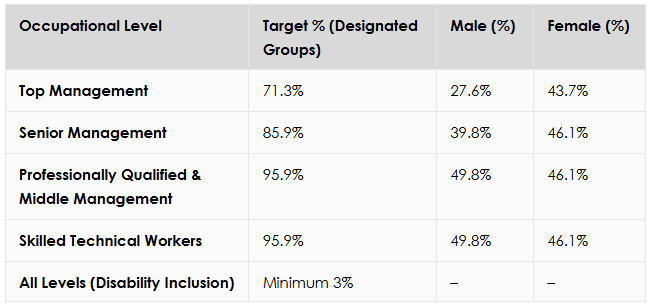
Dhevarsha Ramjettan, Nivaani Moodley, and Kanyiso Kezile write on employment equity
By Dhevarsha Ramjettan, Partner, Nivaani Moodley, Associate Director and Kanyiso Kezile, Trainee Attorney from Webber Wentzel
The Department of Employment and Labour has ushered in a decisive moment for transformation in employment equity in South Africa’s human health and social work activities sector (the health sector). With the publication of the national economic sectors and sectoral numerical targets, now in effect as of 15 April 2024, employers in this sector face new legal and ethical responsibilities to accelerate transformation and inclusion across all occupational levels.
A new era for employment equity in the health sector: Sectoral targets now in force
According to Section 15A(2) of the Employment Equity Act, 1998 (EEA), new numerical targets have been set to ensure that qualified individuals from designated groups are fairly represented at all job levels. For a sector so profoundly connected to the nation’s well-being, the implementation of sector-specific employment equity targets marks more than just regulatory change; it signals a foundational shift toward greater inclusion and accountability. The health sector, as classified by the Department, encompasses three key sub-sectors: human health activities, residential care activities, and social work activities without accommodation. Each plays a vital role in delivering healthcare and social support services across South Africa.
The newly gazetted targets place designated groups, namely black people, women, and persons with disabilities, at the centre of a new equity framework. Designated groups are defined as citizens of the Republic of South Africa by birth or descent, or those who became citizens by naturalisation. Designated employers in this sector are now legally required to integrate clearly defined sector-specific numerical targets into their Employment Equity Plans (EEPs), with accountability measures to track progress and enforce compliance.
What are the targets for the health sector?
The targets are as follows:

As illustrated above, the targets are set for the top four occupational levels. Employers may elect to use either national or regional Economically Active Population (EAP) data, depending on the geographic spread of their operations, as a benchmark when setting their numerical targets.
These targets are legally binding, not aspirational. Designated employers must actively report progress towards these thresholds in their annual submissions to the Department. Failure to meet or demonstrate sustained progress may result in increased scrutiny, the withholding of compliance certificates for employment equity, and disqualification from doing business with the State. These figures, therefore, provide a compliance yardstick for designated employers.
Key implications for health sector designated employers
Designated employers must update their EEPs to reflect the numerical targets applicable to their workforce size and sector classification. These targets are legally binding and will inform compliance assessments and the issuing of compliance certificates, without which employers may be barred from doing business with the State.
All designated employers in the health sector are required to prepare and implement EEPs for the period 1 September 2025 to 31 August 2030. This plan must outline the employer’s strategy to achieve equitable representation across occupational levels, in line with the newly introduced sectoral targets.
Employers who become designated after 1 April 2025 will still be required to develop an EEP that covers the remainder of the five-year cycle, up to 31 August 2030. In drafting these plans, employers must refer to the relevant Codes of Good Practice issued under section 54 of the EEA.
The 3% disability target is a mandatory sector-wide requirement. Given the health sector’s role in driving inclusive care, employers are now expected to model disability-friendly workplaces and proactively recruit and retain persons with disabilities.
What should employers in the health sector do now?
Employers in the health sector should act swiftly to align with the new sectoral targets by reviewing and updating their existing EEPs. This includes conducting workforce audits to identify representation gaps and barriers that hinder the attainment of an equitable, nondiscriminatory workplace.
Meaningful engagement with Employment Equity Committees is key to creating effective implementation strategies. Employers should also invest in targeted skills development, retention, and succession programmes that support the advancement of designated groups in both clinical and administrative roles.
Finally, we must equip senior leadership with the necessary training and hold them accountable for driving and sustaining transformation across all levels of the organisation. Transformation within the health sector is not just about meeting targets; it is about building a more inclusive and responsive health system. Employers must lead decisively and ensure that their employment practices reflect both the spirit and the letter of the law. Employers should conduct a thorough analysis of their workforce, policies, and procedures to identify and address any barriers to compliance with employment equity.






